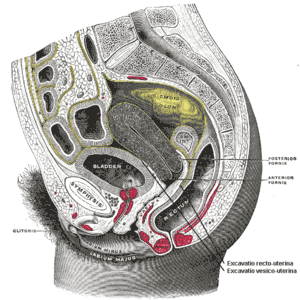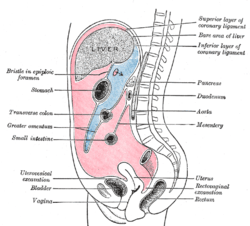Vesico-uterine pouch
In human female anatomy, the vesico-uterine pouch, also known by various other names, is a second but shallower pouch formed from the peritoneum over the uterus and bladder, continued over the intestinal surface and fundus of the uterus onto its vesical surface, which it covers as far as the junction of the body and cervix uteri, and then to the bladder. This pouch is an important anatomical landmark for chronic endometriosis. Endometrial seeding in this region causes cyclical pain in women of child bearing age. This pouch is also an important factor in a retroverted uterus, which can frequently complicate pregnancies.
| Vesico-uterine pouch | |
|---|---|
 Sagittal section of the lower part of a female trunk, right segment. (Excavatio vesicouterina labeled at bottom right.) | |
 The epiploic foramen, greater sac or general cavity (red) and lesser sac, or omental bursa (blue). Uterovesical excavation labeled at bottom left, third from the bottom. | |
| Details | |
| Identifiers | |
| Latin | excavatio vesicouterina |
| TA | A10.1.02.504F |
| FMA | 14729 |
| Anatomical terminology | |
The vesico-uterine pouch is close to the anterior fornix of the vagina.
Naming and etymology
The vesico-uterine (or vesicouterine) pouch is also called the vesico-uterine (or vesicouterine) excavation, utero-vesical (or uterovesical) pouch, or excavatio vesicouterina. The combining forms reflect the bladder (vesico-, -vesical) and uterus (utero-, -uterine).
Additional images
 Median sagittal section of female pelvis.
Median sagittal section of female pelvis.
See also
References
This article incorporates text in the public domain from page 1152 of the 20th edition of Gray's Anatomy (1918)
External links
- Anatomy photo:43:02-0102 at the SUNY Downstate Medical Center - "The Female Pelvis: Distribution of the Peritoneum in the Female Pelvis"
- Anatomy image:9612 at the SUNY Downstate Medical Center
- Anatomy image:9736 at the SUNY Downstate Medical Center
- Anatomy image:9758 at the SUNY Downstate Medical Center
- figures/chapter_35/35-8.HTM: Basic Human Anatomy at Dartmouth Medical School